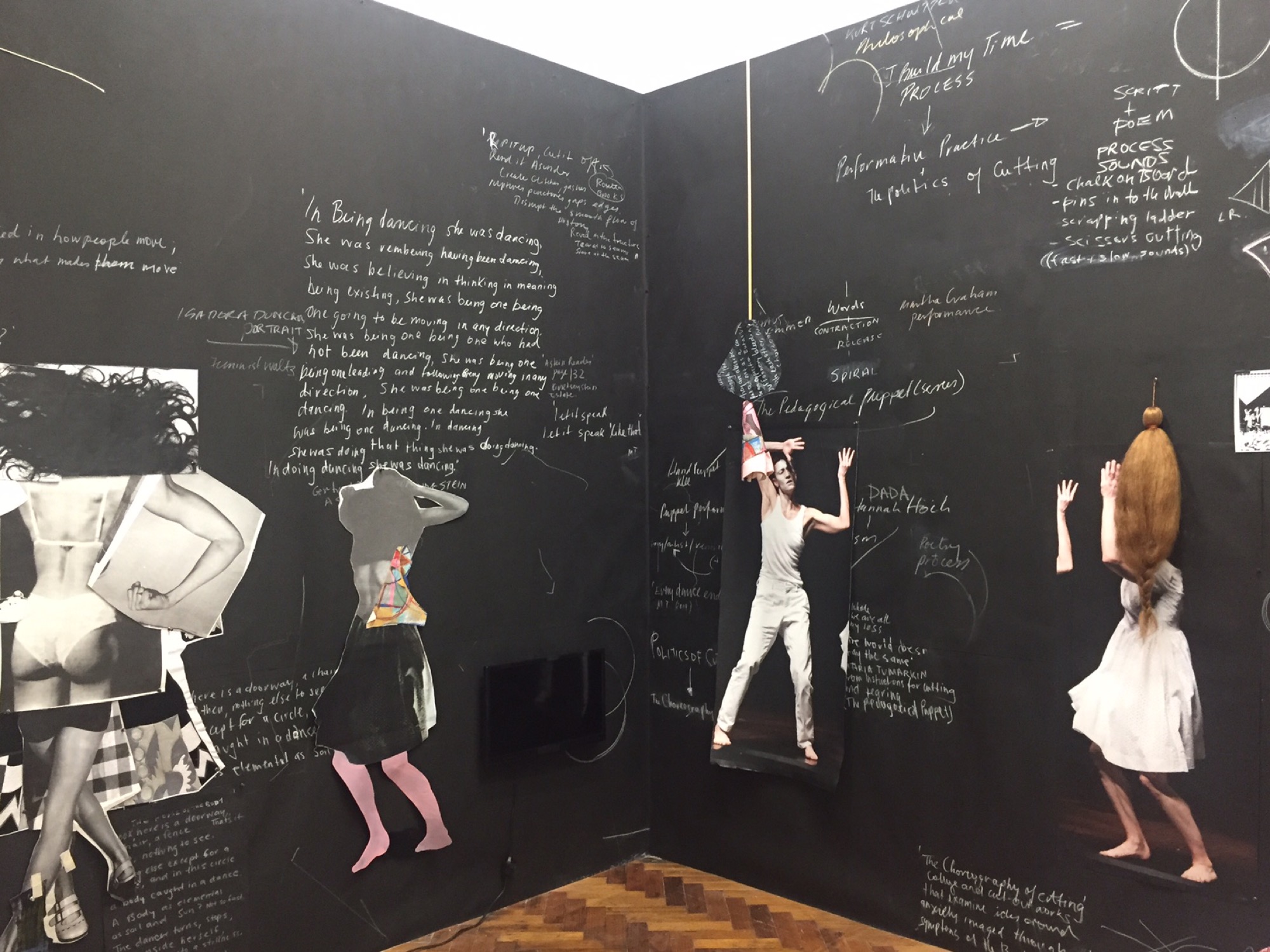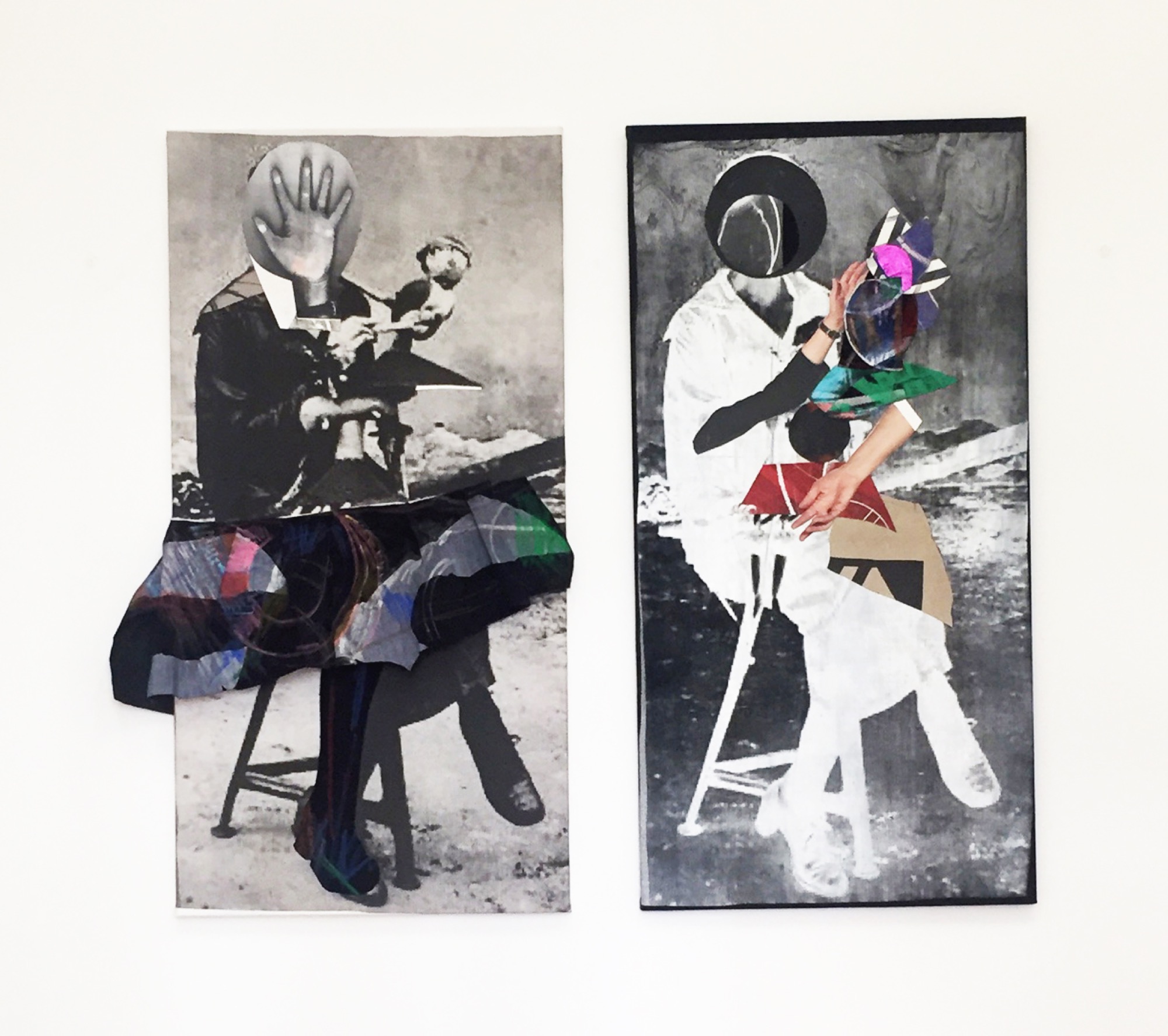Sally Smart: The Choreography of Cutting
Julia Lomas
Sally Smart's exhibition at Sarah Scout Gallery presents work from the artist's major ongoing project The Choreography of Cutting (2014–), alongside pieces that continue her 2012 series The Pedagogical Puppet. The synthesis of these two research projects combines to form the exhibition's enquiry into the intersection of dance, movement and pedagogy. The assemblage and collage works on show investigate cutting and pastiche as formal expressions of Smart's layered and synergetic approach to dance and pedagogy as both spatialised and dynamic practices.
Perhaps the most ambitious creations on display are the two assemblage works that reference the theatre and costume design of the early twentieth-century avant-garde dance company, The Ballets Russes. Under the direction of Sergei Diaghilev, The Ballets Russes famously commissioned costume and set design from a coterie of modernist artists including Pablo Picasso, Henri Matisse, Natalia Goncharova and Sonia Delaunay. Leon Bakst, who acted as an artistic director of the company, had stipulated to his costumiers that pattern designs were to be meticulously embroidered and hand-beaded; Mikhail Larionov's sumptuous and ornate costumes for the Chout ballet were then famously so heavy that it was apparently impossible for dancers to move freely. Smart has responded to this legend with her own recreations of the original Ballets Russes designs, using digital images of the costumes and splicing these with embroidered and patch-worked fabrics.

In the first room of Sarah Scout, an opulent wall-hanging dominates the space. Performance/Punokawan (Chout Rehearsal) (2017) is an assembly of theatrical elements: a pastiche of embroidered fabrics forms a forest scene decorated with abstracted gestural and geometric shapes, digital images of a dancer's body and animalistic forms, and colourful, high-keyed patterning. Much of the tapestry's imagery and adornment is tacked or left to hang off the fabric, while wooden rods suspended from the ceiling support heavier pieces so that that the total effect is of a three-dimensional chorus of colour and texture.
Next to this, Performance Assemblage (Uniform) (2017) is an ensemble of fabric shapes and textures, spliced together into a rough tunic shape. As part of the exhibition, dancer Brooke Stamp was commissioned to produce a short performance piece. Robed in one of Smart's assemblage costumes, Stamp's performance explored the dynamics of motion against the backdrop formed by the Chout tapestry, responding to the idea of failed or impeded movement that is conjured by the fable of Bakst and Larionov's exacting and onerous standards.

Hannah Höch is another important protagonist of the exhibition; a decision that seems to deliberately address Hannah Höch's historically under-acknowledged contribution to the Dada movement. A 1920 photograph of Höch balancing one of her Dada Dolls on her knee has been reworked and recombined in four collage portraits, alternately titled Hand Puppet H.H. Global (The Pedagogical Puppet) and The Choreography of Cutting (further qualified with 'Modern Puppen' and 'Hand Puppen' in parentheses). The collage portraits all riff on the same image of Höch; a quick image search reveals the photo is from the 1920 First International Berlin Dada Fair. Each portrait reproduces this photograph rendered in varying degrees of opacity and inversion. The images are then further embellished with rich textures of heavy velvet gathered and ruched to form skirting, blue gingham cotton, gestural patterns in paint and crayon, hessian orbs and collaged photographic imagery of hands.
In the second room of the gallery, two of these Höch portraits are placed in dialogue with one of Smart's own puppet-sculptures and a large-format photograph of the artist holding a marionette of her own likeness in puppet form, each figure in the photo topped with a characteristic crop of vermilion hair. In Pedagogical Puppet (Self Portrait) (2012), the artist stands on a small wooden block manipulating the marionette. Smart's puppet replica is a spindly, oddly dignified creature; the work's investigation of puppetry honours the medium's status as a pedagogical tool and an ancient art form and means of communication. In the photograph, the space around the two figures is darkened, and their black clothing heightens the sense that the figures melt in and out of a liminal environment. The accompanying sculpture, Punkawan Puppet (2017), is a diminutive puppet form fashioned out of air-dried clay and dressed in a scrap of pink gingham. Stitching down the form of the puppet's limbs emphasises the puppet's body as a hand-crafted assembly, and the overlap of dress and limb components bisecting each other also mimics the gestural, abbreviated figures of a Matisse cut out.

In the last gallery, a blackboard painting sketches a constellation of theoretical and artistic forebears. The Choreography of Cutting (The Pedagogical Puppet Projects) (2017) constructs an immersive textual and visual web of philosophic and aesthetic studies to create a patchwork of quotation and sketches. Modernist dancer and choreographer Martha Graham and the movement theorist Rudolf Laban have been particular sources for Smart's ongoing investigations; they are joined here by references to Gertrude Stein, Kurt Schwitters, Sophie Taeuber Arp, Joseph Beuys and the Bauhaus School. The blackboard is itself a reference to the pedagogical process of Rudolf Steiner, who created improvised blackboard paintings during his lectures. An excerpt from Stein's 1912 Portrait of Isadora Duncan, Orta, Or One Dancing, inscribes the action of dance into a textual, melodic incantation that meditates on the relationship between movement, being, thinking and remembering. The reference to Schwitters might also remind viewers of his Merzbau, a room-sized installation that was itself stitched together out of fragment and scraps of material.
Photographs of women's figures in dance-like movements are pinned to the black canvas and spliced together with collaged photo cuttings, and strips of fabric patched in an array of colour and pattern. Like the tapestry next door, the blackboard moves in and out of two- and three-dimensional space. A thick wig of golden chestnut hair is hung bunched and plaited over the top of one figure; elsewhere an arrangement of orbs fashioned from embroidered material and attached to a conical swathe of fabric forms a pendulum hanging from a long wooden pole. A small monitor projects the video work Hannah/Martha (Pedagogical Puppet Projects), 2016–17, where shadowy puppets figures dance across the screen.

The fragmentary and citational form of Smart's blackboard acts as a culmination of the patch-working of fabrics and materials that constructs the exhibition. The blackboard painting acts as both a materialisation of the artist's process of working through her research material and as an embodiment of the veneration of the fragment that was central to the modernist practices of writers such as Stein.
But the exhibition feels like more than an interlocked homage to modernist interdisciplinary experimentation. Smart's investigation of movement through both dance and the playful pedagogy of puppetry seems also to explore the feminine body's navigation and mediation of space. Situating Hannah Höch as a central figure imagines Höch as a key actor in the story that Smart's exhibition seems to be telling. Similarly, the extract from Stein's Orta reinforces an image of a woman dancing as a means of inhabiting and creating space. Both the puppet and the dancer's body are mediums through which the fields around these figures become more visible. Smart has mined these art forms for the manner in which they are modes of spatial expression, splicing together a tapestry of historical reference. Indeed, one reading of this exhibition might imagine that the elements of tapestry, costume and puppetry are components of Smart's own theatrical décor; the blackboard drawing gathers the scripts and narratives of the exhibition as a yet unfolding process of learning and extrapolation.
Julia Lomas is a PhD Candidate in Art History and Theory at Monash University.
Title image: Sally Smart, The Choreography of Cutting. (The Pedagogical Puppet Projects), 2017. Courtesy the artist and Sarah Scout Presents)


